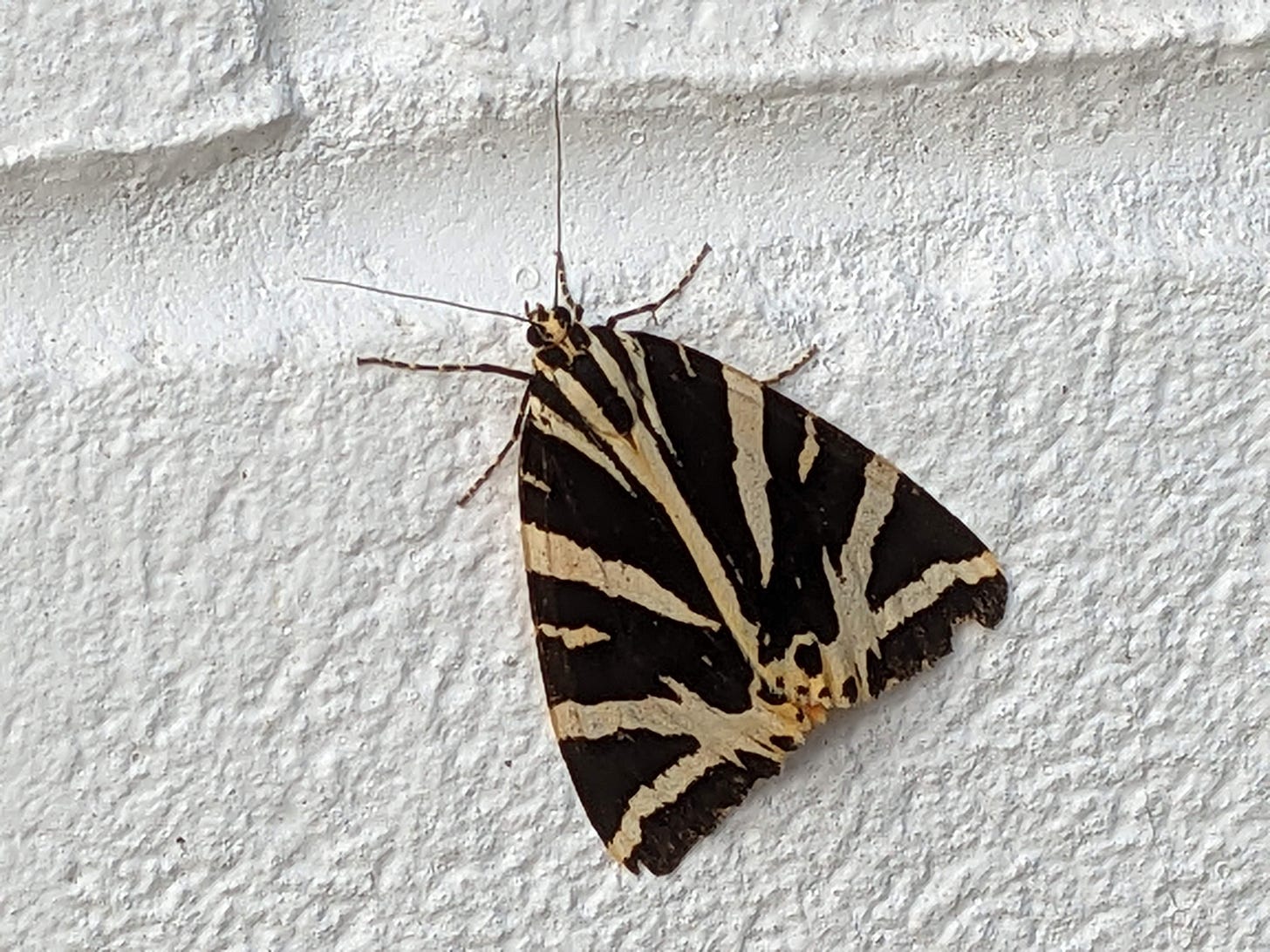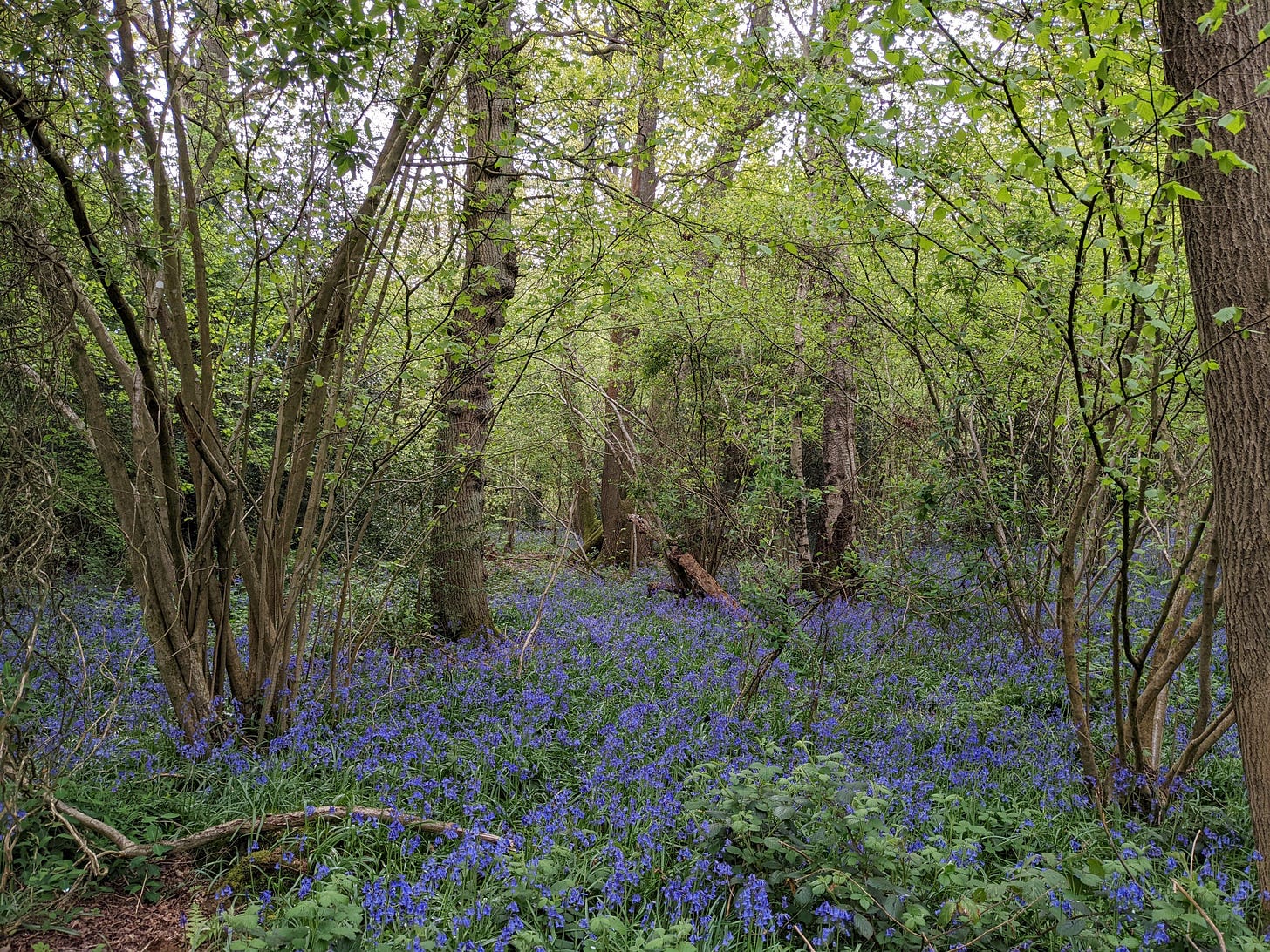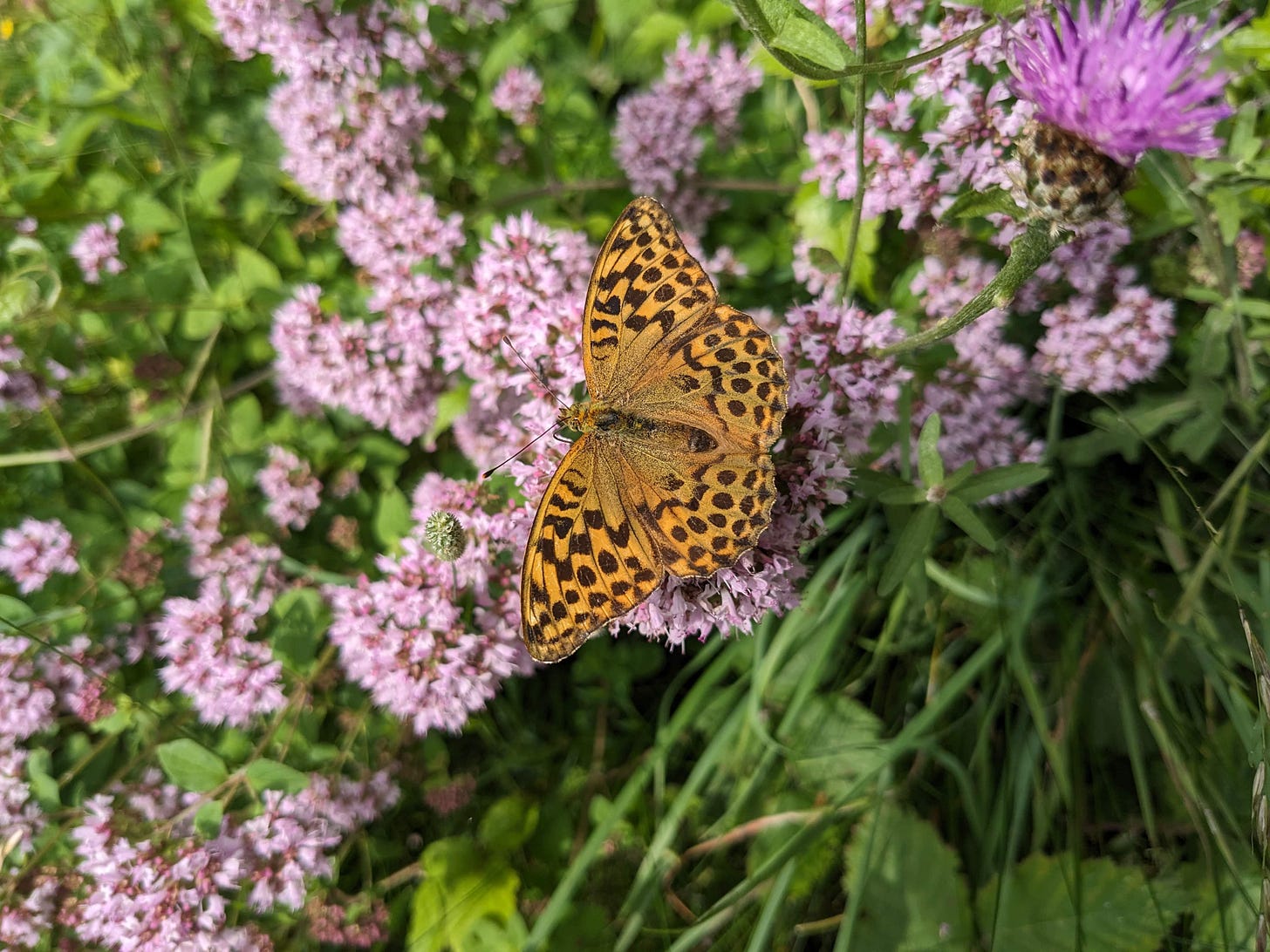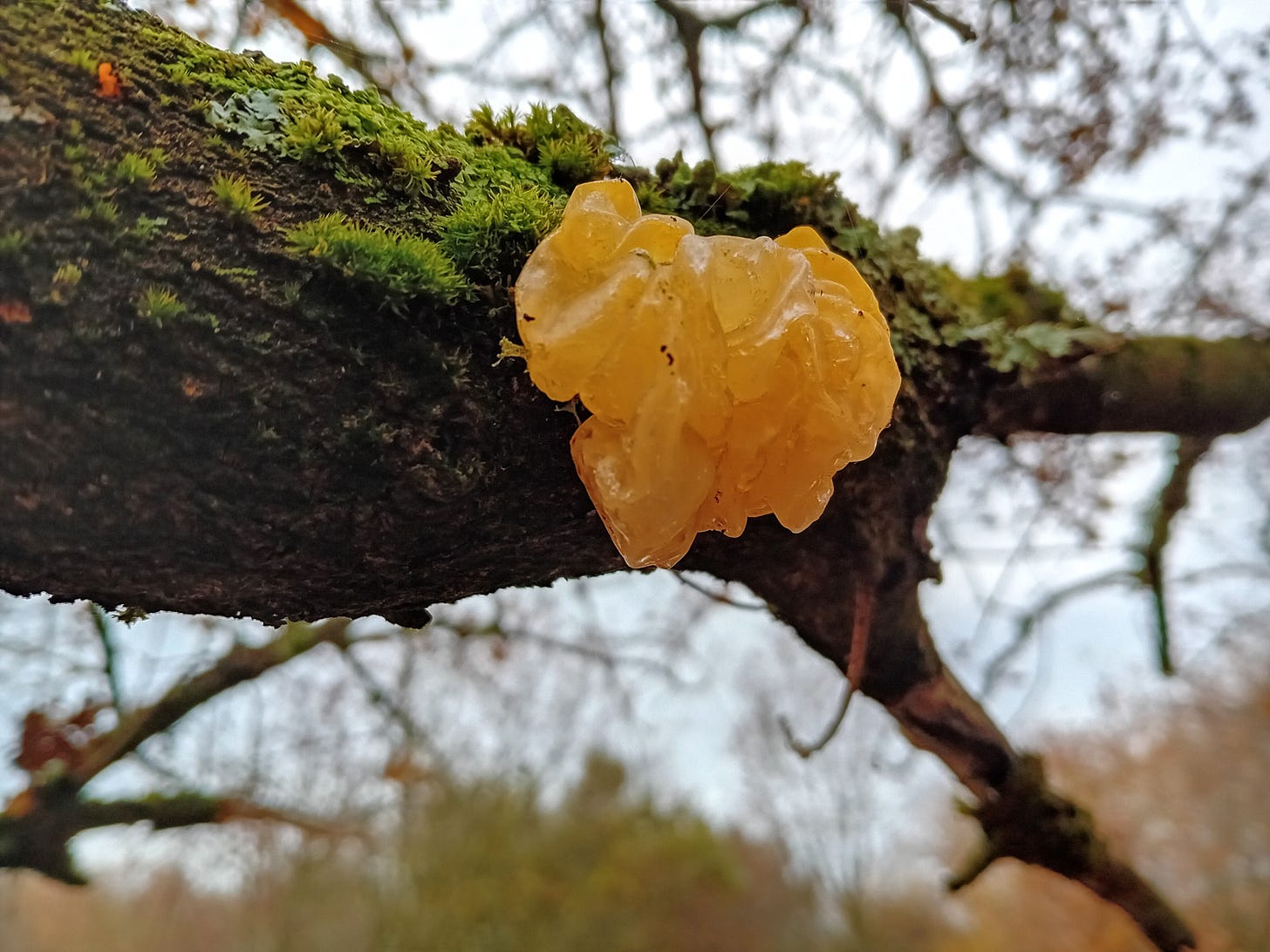Getting to know the neighbours
On learning the names of other species, and why it matters
While out walking beside the River Darent in Kent one sunny Sunday earlier this month I came across an area where there were lots of bright blue damselflies with dark wings. It was wonderful to see so many, especially as there is such anxiety this year about the dearth of insects. I didn’t know what species they were and as they were behaving just as such insects usually do - darting about and never settling long in one place – it was impossible to get a good enough picture to use an app for identification.
A few years ago, I would have been content to enjoy the sight of such beautiful insects on a peaceful, sunlit stretch of river and I would not have been particularly worried about identifying them. But I’m more curious these days so I did some research later and it seems most likely that they were male Banded Demoiselles. There were also a few brownish coloured damselflies which were probably the females.
Without a photograph, I’ll never know for sure but the act of trying to identify them has given me an opportunity to learn more about these insects and next time I spot something similar, I should have more chance of identifying them. If I can remember the relevant details, of course. That’s one of the challenges of wildlife ID, retaining the vast amount of information that is needed to distinguish one species from another. But I’m slowly improving.
When I started volunteering, I could barely name anything but the most common of woodland plants. As I have slowly learnt to identify flowers other than bluebells and buttercups and to distinguish a hornbeam from a beech, I have realised just how much more variety there is than I had appreciated before. It is a bit like deciphering a code or learning enough of another language to be able to read the shop signs when you are in a foreign country. In Wildwood, Roger Deakin describes seeing unfamiliar plants and trees on a trip to Australia and feeling closer to them once he learns their names. “It was like meeting people,” he writes. I know what he means now. The amorphous, anonymous mass of tangled greenery that I too often ignored on previous visits to the woods began to take on a new significance when I could see the rich variety it contained.
It’s not that I didn’t notice wildflowers before, it’s just that until I started learning more about them, I didn’t realise quite how many there were and just how important it is to have a diversity of species. And the names themselves - Devil’s Bit Scabious, Yellow Rattle, Greater Stitchwort - are great too. Being easier to photograph makes plants easier to identify than many other species, particularly with the help of apps like i-Naturalist. But as I’ve started getting a little more confident, I’m trying to use apps to check my own identification more often rather than relying on them entirely and it’s a good feeling when I get it right. Even better is knowing that the sightings I submit through i-Naturalist are contributing to a database of records that researchers can use.
Since getting involved in a regular butterfly survey, I’ve also become familiar with all the butterflies we see locally and a few more besides. There are a only a few dozen species of butterfly in the UK so it should be possible to learn them all. But something like fungi ID is a very different proposition. Not only are there so many species - around 15,000 - but they can change so much according to weather conditions and stages in their life cycle, that identifying them can be extremely tricky. I’m full of admiration for people who’ve taken the time to develop this kind of knowledge.
I’ve asked various experts how they developed their ID skills, assuming they must have developed these at a young age, or while studying ecology at university, but that often turns out not to be the case. Usually, it’s something they have taught themselves, or learnt through spending time with other very knowledgeable people. And while I’m still far from being an expert, this echoes my own experience. I’ve learnt a lot simply from asking questions while spending time with people who know a lot more about wildflowers, birds or fungi than I do.
It’s also how people would have learnt this kind of information in the past. In Gathering Moss Robin Wall Kimmerer talks about the importance of the traditional knowledge that her ancestors developed from careful observation of plants, and then passed down through the generations. When our survival is no longer dependent on knowing which wild plants are edible and which have healing properties, such knowledge might feel superfluous. And I certainly don’t think anyone should be made to feel that more natural places aren’t for them because they can’t identify the birds they hear or the plants they see. But if we’re to have any hope of solving the nature and climate crisis, we do all need to understand how our behaviour impacts on the other species around us. And we won’t be able to do that, if we can’t even recognise those other species.
So it is very worrying that many people are growing up now without any knowledge of even the most common species. A survey a few years ago found that two-fifths of British children couldn’t identify a dandelion and nearly a quarter didn’t recognise a conker. Such evidence highlights the importance of initiatives such as Forest Schools which give children the opportunity to spend time in places where they can experience the delights of dandelion clocks and daisy chains and in the process learn how to identify these species and many others.
After describing her concern about the lack of plant knowledge in modern society, Wall Kimmerer writes, “Losing their names is a step in losing respect. Knowing their names is the first step in regaining our connection.” I agree. It seems only courteous to learn the names of the other species I see most frequently - I like to think of this as getting to know the neighbours. I also want to take the time to discover the names of species I’m less familiar with and to try to remember those names for the next time we meet, just as I would with any new acquaintance.
To finish….
…a few things I’d like to share:
The i-Naturalist app: This app is great if you’re keen to understand more about the different species you spot but need a little help with ID. After you upload one or more photo of what you’ve seen, the app gives suggestions of what it’s likely to be, based on other observations locally. You can also submit your own sightings which once verified are added to a huge database of wildlife records used by scientists and conservationists. I love the fact that you can discover some quirky little facts when reporting your sightings too. Apparently, the jelly fungus I recorded last autumn has a range of weird and wonderful common names including yellow brain, witches butter and yellow trembler.
Gathering Moss: A Natural and Cultural History of Mosses by Robin Wall Kimmerer. In this series of essays, Wall Kimmerer draws on both scientific expertise and indigenous teachings to highlight just how valuable and fascinating these tiny and often overlooked plants are. She also makes some really interesting wider observations about land ownership, our relationship with the natural world and the importance of learning to see properly what’s around us. The book was published over 20 years ago but has become better known since the success of her more recent book, Braiding Sweetgrass, which I would also highly recommend.
A hi-tec approach to wildlife ID: This short video explains how Network Rail are using technology, including AI, to monitor the wildlife on the trackside land they own. It also features some stunning footage of Buckthorne Cutting, one of several nature reserves along the railway embankments in this part of South London which collectively form an important wildlife corridor. It’s great to see Network Rail putting so much effort into understanding what species these places support.






Oh I agree with this so completely, and it is so beautifully argued in this piece!
Great article. I’m usually an advocate for being able to appreciate things without knowing all the ins and outs and the names of the things to make nature connection less intimidating. But it’s alarming that so few people can name even the most common things. And you’re absolutely right about using the names to understand our impact and reconnect with the world.